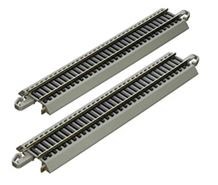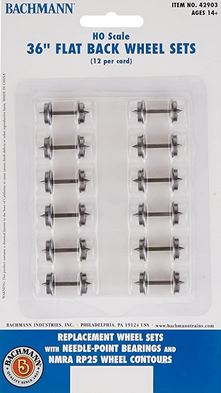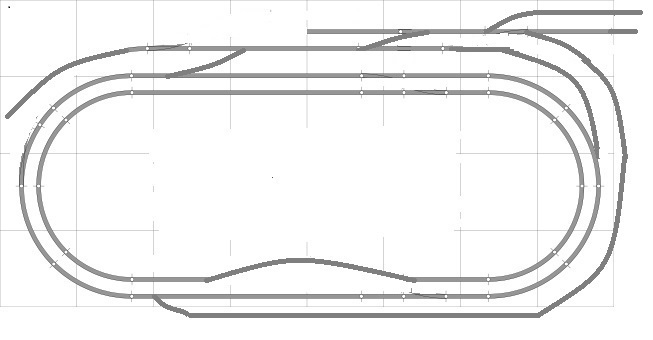Everything on model trains, model railroads, model railways, locomotives, model train layouts, scenery, wiring, DCC and more. Enjoy the world's best hobby... model railroading!
Replacement Motorized Chassis for PA1
Charles is into N scale and asks:
“I’ve been trying to obtain the subject matter for my Con-Cor/Kato Santa Fe PA1. I’ve searched the Web and can’t find what I need.”
Smoking Locomotive
Donald models HO and asks:
“I have a Bachman HO 2-6-2 locomotive that smokes. Q: Is there any way you can clean the smoking unit if it becomes clogged with dried burnt oil inside the smoke stack?”
Two Cars Shorting On New Track
Ian posted this question:
“I operate DCC and just finished laying track and wiring a yard section, siding, and an extension to my mainline. I did this all before getting started on the new scenery and structures. I thought that was smart!! My locos run well on the new track, but I discovered 2 cars caused a short and breaker trip. No problem with the other cars. It happened on the new section of main and the yard, so it’s not down to metal on the track, and it’s the same 2 cars. I got an occasional faint reading on the meter when testing the wheels, so will probably need to replace the Kadee trucks and/or the wheels too. Not sure. Those cars haven’t caused a problem on the existing track, so I am a bit bamboozled why this is this happens. Have others had this problem?”
You can add or view comments below.
6 and 8 Turnout Radius
Here’s a question from Matt:
“Does anyone know the radius of an HO Atlas or Peco turnout numbers 6 and 8?”
You can add or view comments below.
How To Deaden The Sound on EZ Track
“I am past the planning stage of my layout and actually have a few scenery elements in position. My track (I’m using EZ track), is already down, it has been since July, but not fastened in position yet. I don’t 100% like the look, but I will try and hide the ugliest sections if someone has any ideas. I don’t want the added cost of changing to a regular track. That said; I would like to know how I can reduce the noise caused by the big empty space. I went off the idea of expansion foam in case it lifted the track. What do people suggest fill the empty space and deaden the noise?”
Peco Electrofrog Turnouts
“I have DCC and plans for 2 reserve loops, and to replace my #6 custom turnouts with #8 large radius turnouts. Will I need to cut the wire to the wing rail and solder power feeders to the rail and points, or can I just use insulated rail joiners? I want to do it just once and do it right, so would like to know why other guys do. Thank you.”
Motor Not Spinning on Armature
John models N-scale and posted this question:
“My Bachman Spectrum C&O 2-6-6-2 locomotive has a seized (won’t turn) motor. All mechanisms work but the motor won’t turn. It had been running fine but I was wondering if a Digitrax DCC Zephyr 52 power pack running a DC locomotive may have caused overheating? Does anyone have a solution please?”
Stalling Locomotives
Russ has this question you might want to comment on:
“I have a 10’x20’ HO layout and I use an NCE doc system. I usually run two trains each with two locomotives running in a consist. With both trains running at the same time they run flawlessly but if I should stop one of them the other one will stall briefly (and frequently) and start up again. As soon as the stopped train is put into motion the stalling stops. Has anyone else experienced this phenomenon and if so any ideas to correct the situation?”
N-Scale DoodleBug With Lights But No Drive Power
Paul writes:
“I picked up a supposedly never used N-scale DoodleBug the DCC version. After just a short time on the track, it abruptly stopped. The lights are working but there is no drive power. I am unsure what to check for. Any suggestions would be great thanks.”
Please add any suggestions below if you can assist Paul.
Locomotive Pulling Power Formula
 Orjan is hoping someone can assist:
Orjan is hoping someone can assist:
“A friend mentioned a formula I could use to calculate the pulling power of my OO trains, but he couldn’t remember the exact details of how it worked. He said it based on weights, number of cars, gradient percentage and some other factors he couldn’t recall. Does anyone out there know the details and how to use it? I would just like to know. Thank you.”
Derailing Around Curves
Winston models N-scale and asks:
“I just purchased a new GEN 4 Evo. I love the look and sound. However, has anyone had a problem with them derailing? It only derails on 11″ radius curves. (I don’t have a 9 3/4″ on my layout). It always jumps off a quarter of the way through the curve. Yes, the track is level and soldered. I even added some superelevation. That made no difference. My GEN 4 Evo still derails.”
Point Motor Extension Pins
Alan asks readers:
“I have point motors from previous layouts where the pin is to short for my new layout as the baseboard is thicker. How do you make extensions for the pins and what materials do you use .. and the measurements?”
Add your comment or suggestion below.
How To Construct A Model Train Station Kiosk
This video tutorial runs for less than 4 minutes and demonstrates the construction of a scale model train station kiosk/newsstand. The model is made using cardboard and is one of two newsstand models available for download from the website. The models are downloaded in PDF format and can easier be sealed with a clear matt varnish spray of painted with clear matt Mod Podge after construction. This step is purely optional but does nicely seal the assembled model protecting it from dust.
You can view the full range of OO/HO, N scale models and download a free catalog here https://www.modelbuildings.org
Swapping Plastic Wheels For Metal Wheels
“I have a lot of HO cars (different makes) with plastic wheels and over winter want to gradually swap them for metal which I think will run better. What size should I get? I see there are 33inch and 36inch. Does the make matter?”
To view the answers or add your own suggestion, leave a comment below.
Reversing Loop – Insulating Rail Joiners
Jacob seeks help from readers:
“I read where with 4 tracks I could install insulating rail joiners and wire a polarity reversing module, but I don’t really want reversing modules. Can I just connect another power lead to the dead loop section instead? I’m DCC by the way.”
If you can assist Jacob, please add your comments below.
Rerailer Issues – What Am I Doing Wrong?
Ryan asks:
“My layout has 4 powered rerailers and I thought I would connect my first rerailer on one side to the control board and connect from the other side of that rerailer to the next rerailer and continue from there. I connected my main feed and all seemed ok until I joined up the next rerailer. My control started to flash quickly which I presume is a warning I have done something wrong. What? Thanks in advance.”
Track Wiring Help Needed
Alex from New South Wales in Australia asks readers:
“I’m new to model trains and I need help to wire the 4 tracks. As you can see on my map I have 4 transformers to run 4 trains but not at once as they share the same track. Can you help me in wiring it?”
How To Make This White House From Cardboard to OO, N, or HO Scale
Cardboard is recommended for the construction of N scale, OO, and HO scale models, however, foam board or corflute can be substituted on some of the side walls when building to OO or HO scale as is demonstrated in this video. Corflute and foamboard are generally too bulky for making N scale models.
You can see the full range of scale model houses and download your free catalog at https://www.modelbuildings.org


















